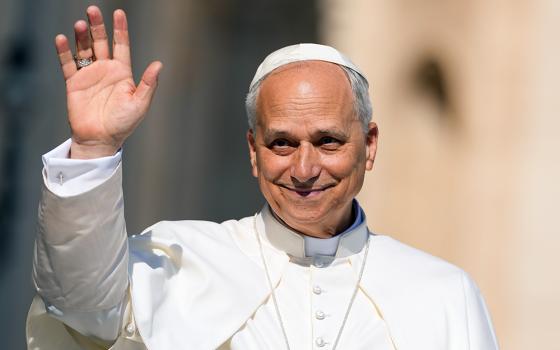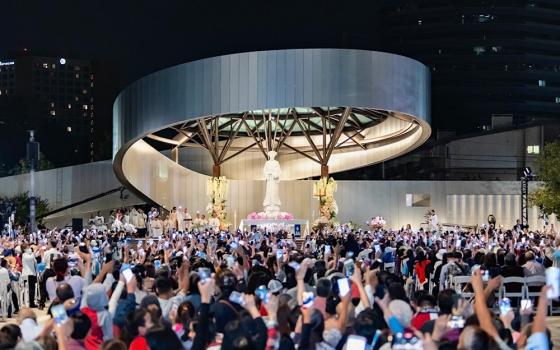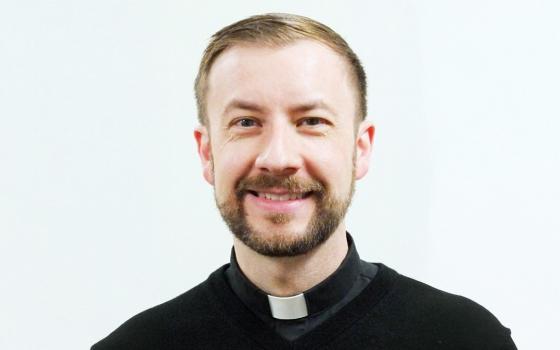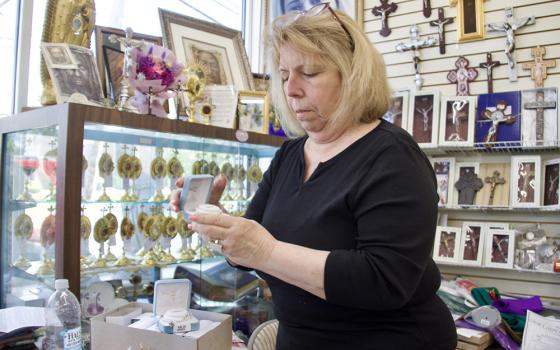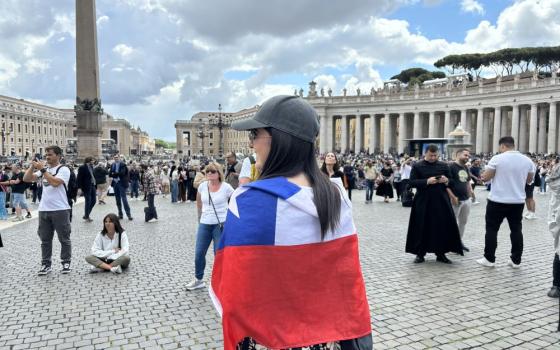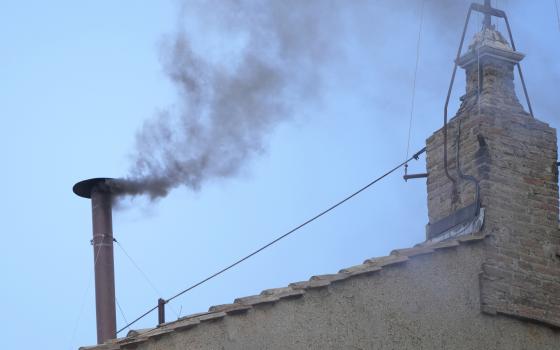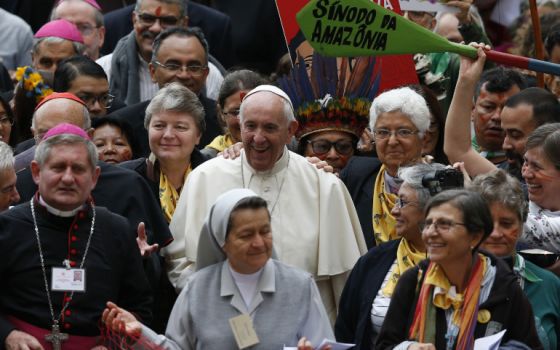
Pope John XXIII prays after his election in 1958 at the Vatican. (CNS)
"It's not only the Holy Spirit at work in that chapel!" a member of the Vatican Curia told me.
There is an unavoidable political aspect to a conclave. Not craven politics or horse trading, although there is some of that. After all, there are three cardinal electors from Chicago, where the living vote early and often, and the dead vote twice: the incumbent Chicago archbishop, Cardinal Blase Cupich; the archbishop emeritus of Washington, D.C., Cardinal Wilton Gregory; and the prefect of the Dicastery for Bishops, Augustinian Cardinal Robert Prevost.
The politics is rooted not in competing interests so much as in different ideas about the future of the church, differences that are rooted in serious and substantial theological commitments. It has always been thus. In the Acts of the Apostles 15:1-21, we read about the Council of Jerusalem at which the apostles debated whether the gentiles must be circumcised before being welcomed into the church.
History, however, is not only the unfolding of ideas and personalities. Events determine outcomes also and events have a life of their own. As different as a papal election is from every other kind of election in the modern world, each conclave nonetheless has an internal dynamic that is revealed in the voting. Each conclave is different, although some conclaves warrant comparison with others.
The most common dynamic in the past 100 years has been a relatively speedy election in which the front-runner wins. In 1939, 1963 and 2005, that was the dynamic. Even though some cardinals opposed the front-runner, so long as his vote totals increased on each ballot, the opposition eventually discerned that the choice was no longer between the front-runner and some ideal candidate. The choice was between getting behind the front-runner or risking a prolonged conclave, which would signal to the rest of the world that the leaders of the church were hopelessly divided. The latter option has little appeal to men who have dedicated their lives to the church.
In the October 1978 conclave, however, a different dynamic emerged. The front-runner was Cardinal Giovanni Benelli, the longtime aide to Pope Paul VI. Benelli had worked as the future pope's private secretary immediately after World War II, and held the powerful position of sostituto, effectively the chief of staff of the pope, from 1967 until 1977, when Benelli was named archbishop of Florence, Italy. He had been the kingmaker in the August 1978 conclave that elected the patriarch of Venice, Italy, Albino Luciani, who died a month after becoming Pope John Paul I.
When the cardinals gathered in October of that same year, it seemed natural to turn to Benelli, but this time, the opposition held firm. Some feared Benelli was too much of a curialist, having spent his entire career in the Vatican Curia or the diplomatic corps. He had been a pastor of a local church, Florence, for only a year. Many cardinals who worked in the Curia feared Benelli knew where all the skeletons were buried and they didn't want anyone digging around.

A street scene in Rome after the death of Pope John Paul I in late September 1978. The conclave that followed in October elected Pope John Paul II. (CNS/Michelle Noon)
Benelli could not secure the two-thirds plus one majority needed for election. The conclave went to a third day, and Cardinal Karol Wojtyla of Krakow, Poland, was elected, becoming Pope John Paul II, the first non-Italian pope since 1523.
This year's conclave could see a similar pattern if the candidate believed to be the front-runner, Cardinal Pietro Parolin, starts out strong, but enough cardinals indicate they will not vote for him that the conclave begins searching for new candidates.
This week's conclave is different from the 2013 conclave that elected Pope Francis, in that there is no sense of crisis at the Vatican. When Pope Benedict XVI retired, the Vatileaks scandal loomed large and there was a strong anti-curial sentiment, mostly directed at Benedict's incompetent secretary of state, Cardinal Tarcisio Bertone. Apart from the noisy detractors of Francis, who are louder than they are numerous, there is no sense of crisis now.
The conclave this year is similar to 2013 in that there is an Italian front-runner and several other potential candidates. On the first round of balloting in 2013, three main contenders emerged: Cardinal Angelo Scola of Milan; Cardinal Jorge Bergoglio of Buenos Aires, Argentina; and Canadian Cardinal Marc Ouellet, prefect of the Congregation for Bishops. Scola underperformed, while Bergoglio and Ouellet overperformed.
On the second ballot the next morning, Bergoglio garnered many of the votes that had gone to candidates who received only one or two votes on the first ballot. He overtook Scola in the vote totals, and most of Ouellet's votes swung to Bergoglio on the third ballot. If, however, Bergoglio had faltered, Ouellet's candidacy might have gained steam or a fourth candidate could have emerged.
Advertisement
Arguably, this year's conclave is most like that of 1958, which saw the election of Pope John XXIII after the death of Pope Pius XII.
Pius XII and Francis had appointed most of the cardinal electors who assembled after their deaths. Those electors remembered previous pontiffs, but because Pius XII and Francis both filled out the role so distinctively, those memories of prior popes had dimmed. Pius and Francis had given the papacy a distinct shape, albeit very different shapes; they were larger than papal life to the cardinals who gathered to select a successor.
None of the electors so closely resembled Pius or Francis as to become a "dauphin," an obvious choice for continuity. And, in both cases, while the vast majority of cardinals admired the previous pope enormously, they might want someone of a different temperament, less haughty than Pius, less unpredictable than Francis. That is why the 1958 conclave was so wide open and why this week's conclave feels the same way.
There are stark differences between the conclaves of 1958 and 2025, the most obvious being their size and geographic distribution. On Wednesday, 133 cardinal electors will enter the Sistine Chapel, 16 of whom are Italian. A record 95 countries have a cardinal in the conclave. In 1958, there were only 51 cardinal electors, with 21 countries represented. The 17 Italian cardinal electors drove the train.
Additionally, the media in 1958 was much less intrusive and there was no social media of the kind we have today pushing the church into sectarianism.
In 48 hours, the cardinal electors will be sequestered and the conclave will begin. All of us on the outside must wait to find out the results of what is happening inside.
For all the changes of conclaves in the past 100 years, the constant is this: The men in that chapel are churchmen. However different their conceptions of what the church needs, they all want the good of the church. A long conclave would suggest a bitterly divided church and the church is not bitterly divided. We will have a pope before the weekend.

